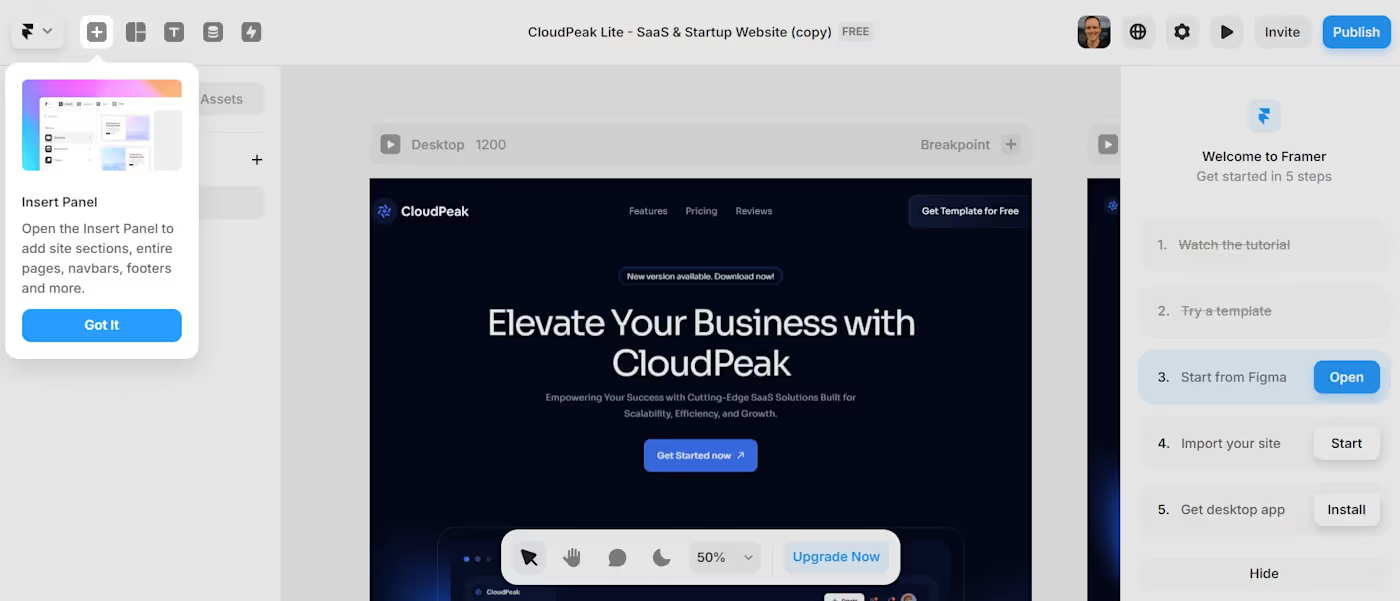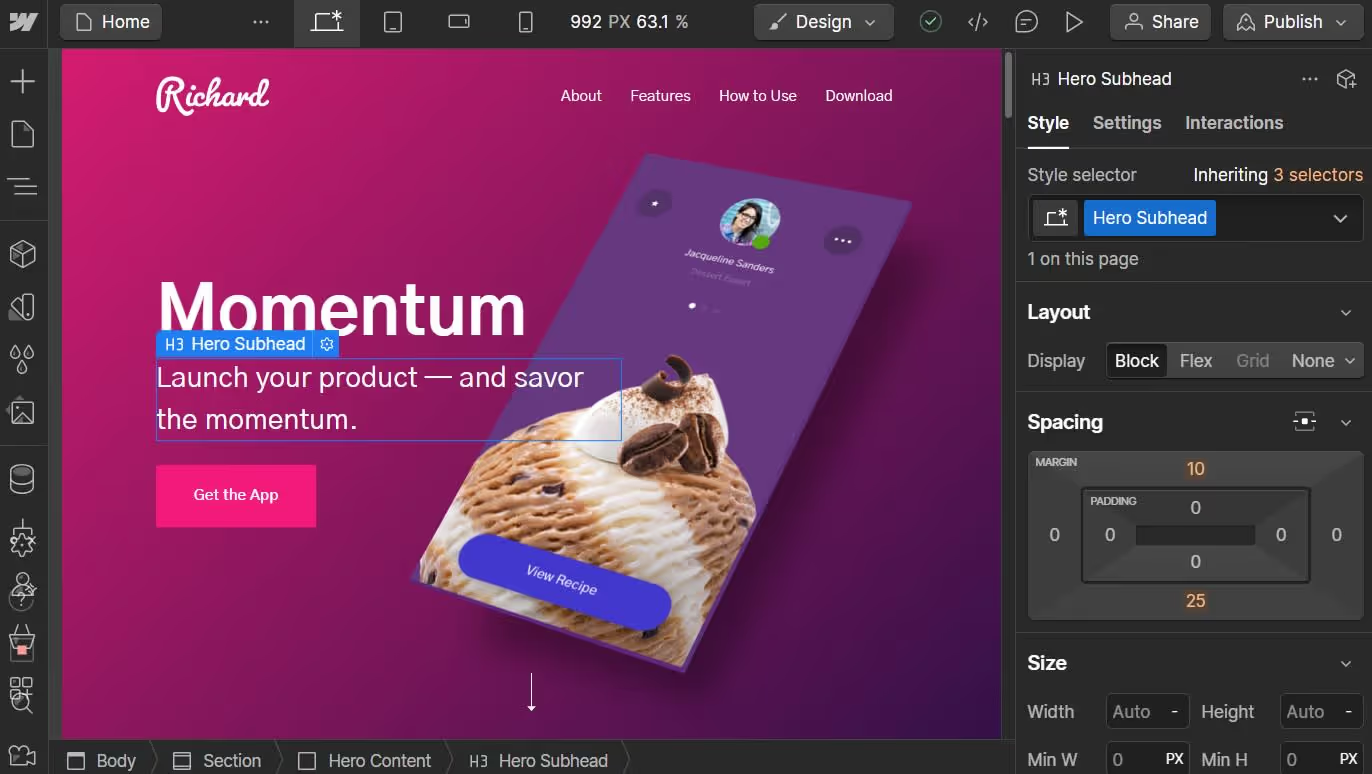In the dynamic world of web design and development, “no-code” and “low-code” tools have revolutionized the way we create websites. Two giants stand out in this space: Framer and Webflow. Both platforms promise the ability to design and launch impressive websites without writing code (or with very little), but which one is right for you?
Choosing the right tool can mean the difference between an agile and successful launch or a frustrating project full of obstacles. This article will guide you through a clear and practical comparison to help you make the best decision based on your needs, experience, budget and type of project.
What is Framer? What is Webflow?
Framer: The Power of Interactive Design, made web
- Origin and Approach: Framer began as an advanced prototyping tool, loved by designers for its ability to create complex interactions. Recently, it has evolved to become a complete website building platform. Its approach is eminently “design-first”, inheriting an interface very familiar to those who use tools like Figma.
- Who It's Designed For: Mainly designers (especially Figma users), startups and marketing teams looking to create visually impactful sites with fluid animations quickly.
- Key Strengths:
- Intuitive interface similar to design tools.
- High-quality animations and transitions.
- Fast publishing and integrated performance optimization.
- Great for landing pages, portfolios and sites with a lot of visual emphasis.

Webflow: The Gold Standard for Professional Visual Development
- Origin and Approach: Webflow was born with the mission of allowing designers to build professional websites without depending on developers, but understanding the fundamentals of web development (such as the HTML/CSS box model). It offers granular control over each element.
- Who It's Designed For: Designers with knowledge of HTML/CSS (or willing to learn them), agencies, freelancers and companies that need complex, dynamic websites with a robust CMS.
- Key Strengths:
- Full control over design and structure (HTML, CSS, JS visually).
- Powerful integrated and customizable CMS (Content Management System).
- E-commerce capabilities.
- Extensive community and learning resources.

Direct comparison: Framer vs Webflow
Advantages and disadvantages of each platform
Framer
- Advantages:
- ✅ Fast learning curve for designers: If you use Figma, you'll feel right at home.
- ✅ Spectacular animations: Easy to implement modern visual effects.
- ✅ Publication and speed: Sites usually load very quickly and publishing is simple.
- ✅ Components and Remix: Reuse and share design elements easily.
- ✅ Ideal for: Landing pages, portfolios, marketing sites, startup websites that need to move fast.
- Disadvantages:
- ❌ Less mature CMS: Although functional, it's not as powerful or flexible as Webflow for complex data structures.
- ❌ Less granular control for developers: It's not intended for those who want to touch every line of code.
- ❌ Younger plugin ecosystem: Fewer third-party integrations compared to Webflow.
Webflow
- Advantages:
- ✅ Total design control: Complete mastery over structure and style.
- ✅ Extremely powerful CMS: For any type of dynamic content.
- ✅ Robust E-commerce Capabilities: For customized online stores.
- ✅ Huge community and resources: Tutorials, forums, templates.
- ✅ Ideal for: Complex corporate sites, platforms with dynamic content, e-commerce, projects that require high customization and scalability.
- Disadvantages:
- ❌ Steep learning curve: It requires time and dedication to master it.
- ❌ It may be “too much” for simple projects: Its power can be excessive (and more expensive) for a simple landing page.
- ❌ Less intuitive interface for pure designers: It's more like a development environment.
Who is each tool best for?
Framer is probably best for you if:
- Eres designer (especially a Figma user) and you want to bring your web designs to life quickly.
- You need to create landing pages, portfolios or marketing sites with a great visual impact and fluid animations.
- You prioritize the speed of development and publication.
- Your project is from small to medium size and it doesn't require an ultra-complex CMS.
- You work in a design team that values collaboration in real time.
Webflow is probably best for you if:
- You need total control about the design and functionality of your site.
- Your project is convoluted, requires a Robust CMS (large blogs, directories, databases) or functionalities of E-commerce.
- You are a designer with knowledge of web development you are not willing to learn them.
- Do you work on a Agency or as a freelancer building sites for customers with diverse and specific needs.
- Are you looking for a platform It matures with a large ecosystem of support and extensions.
Use cases and real examples
Framer Case: Landing page of a new SaaS product
Why Framer: A startup needs to quickly launch an attractive landing page for their new software. The design team, familiar with Figma, can transfer their designs to Framer and add scroll animations and microinteractions in a matter of days, not weeks. The CMS is sufficient for a basic blog section and testimonials.
Webflow case: Corporate website with extensive blog and client area
Why Webflow: A consolidated company needs a corporate website with multiple sections (services, us, careers), a blog with hundreds of categorized and labeled articles, and a downloadable resources section. The Webflow CMS allows you to manage this complexity, and its design control ensures that the site perfectly reflects the brand identity. Using Memberstack, you can implement login functions, registration, client areas, and add complex functionality by integrating Webflow with Tally, Stripe, etc., through Make or Zapier.
Conclusion and Recommendation
There's no absolute winner between Framer and Webflow; the “best” tool depends entirely on you and your project.
- Choose Framer if: You prioritize speed, ease of use for designers (especially with Figma experience) and you want to create visually stunning sites with cutting-edge animations, mainly for landing pages, portfolios or simpler marketing sites. It's the agile and modern option.
- Choose Webflow if: You need absolute granular control, a powerful and customizable CMS, e-commerce functionalities, or you're building complex, tailor-made websites. It's the robust and professional option for more demanding projects.
My advice: If possible, try both of them free of charge. Import a simple design to Framer or try to replicate a section of a website in Webflow. This hands-on experience will give you the best perspective.
Frequently Asked Questions
Which one is easiest to learn?
Generally, Framer is easier to learn for those who come from design tools like Figma, thanks to its similar interface. Webflow has a steeper learning curve because it teaches you (or requires you to understand) the fundamentals of web development.
Which one is best for SEO?
Both platforms allow the implementation of good SEO practices (metadata, sitemaps, friendly URLs). Webflow It has historically offered more granular control over technical aspects of SEO, but Framer is improving rapidly and offers excellent load performance, which is an important SEO factor. With both you can achieve good positioning if they are configured correctly.
Can I migrate from one to the other?
Directly migrating a site built on one platform to the other is very difficult and usually not practical. There is no “export/import” tool that preserves the design and functionality at 100%. You would have to rebuild the site on the new platform.
Which one is more expensive?
It depends on your needs. For a simple site, Framer could be more economical. For multiple sites or advanced functionalities such as E-commerce or very complex CMS, the costs of Webflow can scale, especially if you need Workspace plans in addition to site plans. Always compare their pricing pages for your specific case.
Do I need to know code to use any of them?
No, both are “no-code” tools. However, understanding the basics of HTML and CSS will give you a great advantage in Webflow. In Framer, design knowledge is more crucial. Both allow you to add custom code if you need it for advanced functionality.
I hope this comparison will help you make the right decision for your next web project. Best of luck!








